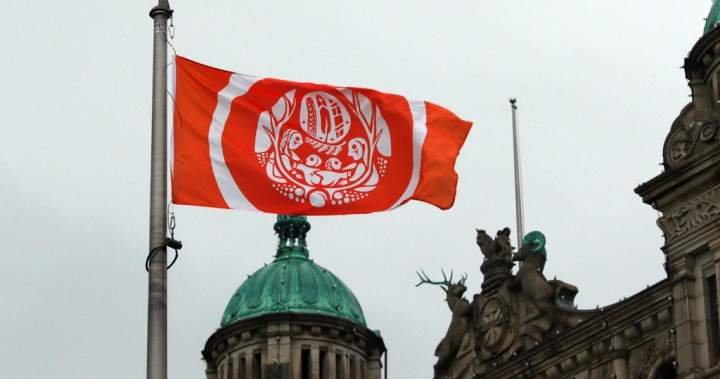An 18-month investigation at a former residential college web site in British Columbia’s Sunshine Coast has discovered extra proof of youngsters who disappeared there, the world’s First Nation says.
The shishalh First Nation in Sechelt, B.C., mentioned in a launch Friday that 41 “extra unmarked graves” had been discovered because of a search with ground-penetrating radar within the space across the St. Augustine’s Residential Faculty web site.
It mentioned the invention introduced the variety of suspected graves on the web site to 81, after preliminary findings that had been introduced in 2023.
“Immediately is a day of loss for our group and for our households,” mentioned Chief Lenora Joe in a video assertion.
“These findings and the areas scanned had been all pushed by the tales and the recollections of our survivors, our elders and relations who’ve been carrying these truths and burdens with energy for a lot of, a few years.”
The B.C. Legislature’s flag would fly at half mast till sundown on Sunday, meeting workers mentioned in a social media put up after the First Nation’s announcement.
The put up mentioned this was “to honour the shishalh Nation, and the survivors, households, and communities impacted by trauma and loss on the former Sechelt residential college.”
First Nations communities have tended to make use of cautious language when saying the findings of radar searches, starting from anomalies and areas of curiosity to doable graves, however the shishalh assertion mentioned graves at St. Augustine’s had been “recognized by archeologists.”
In April 2023, the nation introduced the invention of what it believed to be 40 unmarked grave websites on and round St. Augustine’s. It mentioned on the time that relying solely on ground-penetrating radar for knowledge could be inaccurate and inconclusive, because of the web site of St. Augustine’s being in the midst of Sechelt and having been disturbed and developed.

Get breaking Nationwide information
For information impacting Canada and all over the world, join breaking information alerts delivered on to you once they occur.
On Friday, the shishalh Nation declined to supply anybody for an interview, saying it needed house and privateness.
“As we launch this information, we need to defend our folks and put our group and different First Nations whose youngsters are immediately impacted and linked to this within the forefront,” Joe mentioned in a video assertion.
“We’re not taking possession of this trauma, as a result of that was performed to us. However we’re taking possession of our therapeutic, our message and our future.”
The nation mentioned youngsters from its group in addition to 53 different nations from as far-off as Saskatchewan had been on the residential college, and it had been working with them within the seek for doable graves.
That is the most recent in a collection of statements from First Nations across the province after the Tk’emlups te Secwepemc First Nation in Kamloops introduced the detection of greater than 200 potential unmarked graves by ground-penetrating radar in Could 2021.
Joe mentioned her nation is “deeply saddened” by the most recent discoveries, however the outcomes of ground-penetrating radar scans weren’t shocking to group members.
“We’ve got at all times believed our elders. This wasn’t a college, it wasn’t a selection, and the kids who attended had been stolen,” Joe mentioned. “We didn’t want the (ground-penetrating radar) to show this occurred; we at all times had sufficient proof to know.”
The Nationwide Centre for Fact and Reconciliation on the College of Manitoba says St. Augustine’s, in Sechelt, B.C., operated between 1904 and 1975 underneath Roman Catholic administration with federal funding from 1905 onward.
The primary college constructing burned down in 1917, and a more moderen construction was opened in 1922 earlier than being destroyed by one other hearth in October 1975, simply months after it had been closed.
The centre mentioned mother and father had protested points starting from the standard of schooling to poor food plan and harsh self-discipline on the college in 1923, withdrawing their youngsters from the power.
Joe mentioned in her assertion that survivor accounts reported youngsters allegedly being taken by workers into close by forests at night time and never returning.
“Survivors have carried these horrors, and the disappearances of their siblings, cousins, and friends, along with their very own experiences,” Joe mentioned.
The Indian Residential Colleges Decision Well being Help Program has a hotline to assist residential college survivors and their kin struggling with trauma invoked by the recall of previous abuse. The quantity is 1-866-925-4419.
© 2025 The Canadian Press



